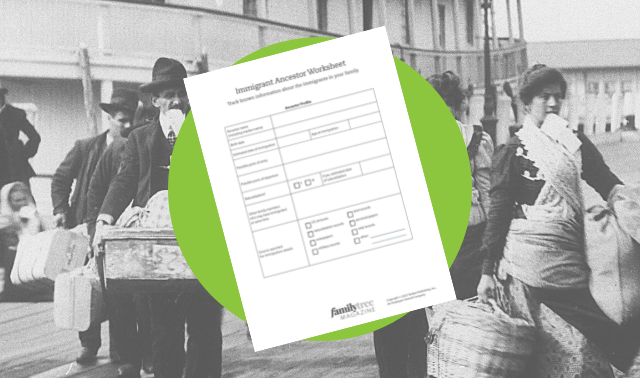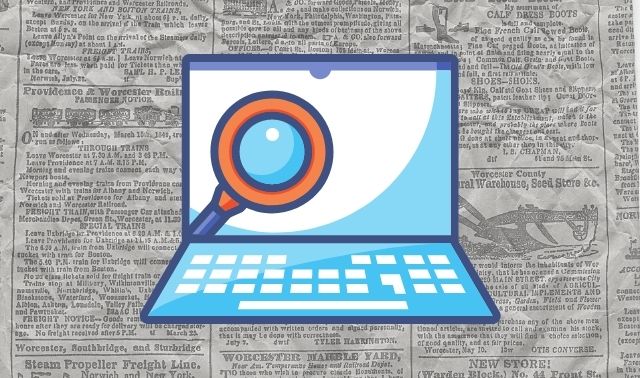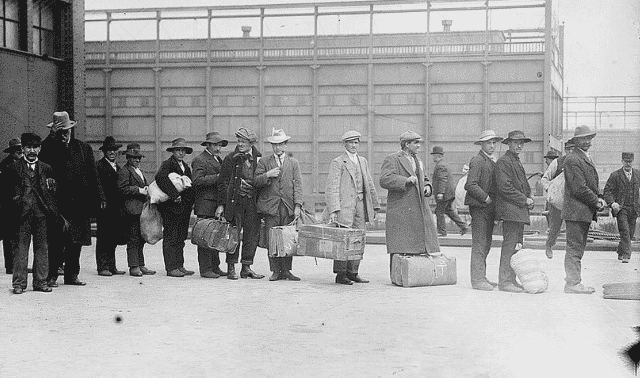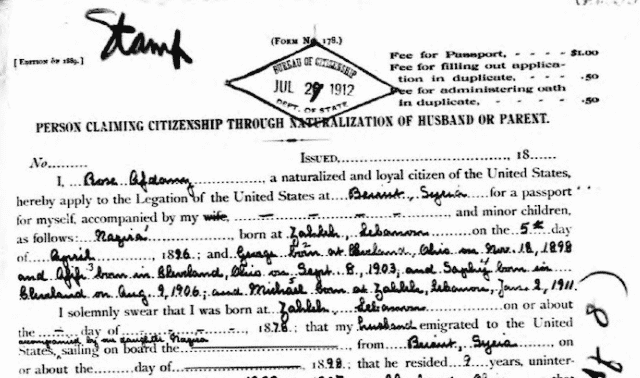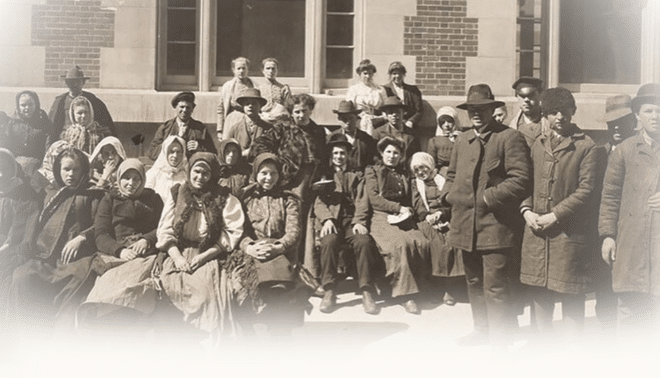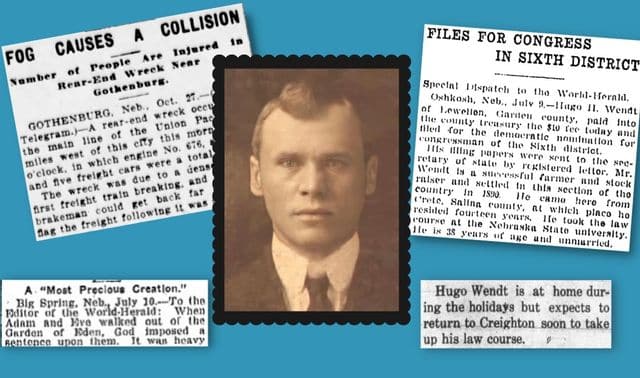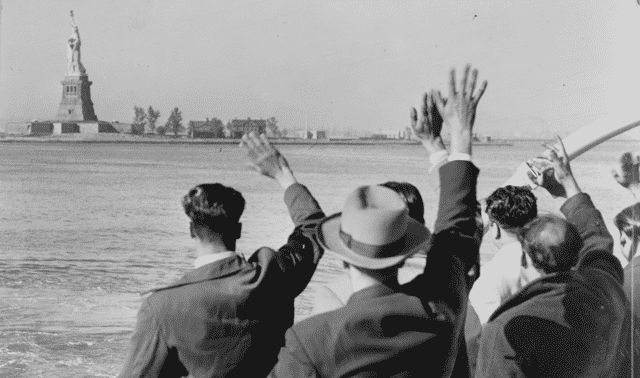
You can’t top the excitement of finding an immigrant ancestor. Discovering that link between Old World and New is what motivates many of us to begin researching our roots in the first place.
Unfortunately, that’s exactly where many genealogists’ searches go adrift. But if you’re in that predicament, the Internet could be your life raft. Many of the key sources for tracing immigrants—passenger lists, published genealogies, newspapers and naturalization records, among others—are hitting the Web, making it quicker and easier to retrace your ancestors’ journey.
To prove it, I’ll show you four examples of how the Internet helped me trace immigrants in my own family history. These people came from four different countries and arrived in three different centuries—some even before the advent of official passenger lists. But I was able to document their origins through the use of online sources, as well as Web-based tools that led me to offline records and publications. Use the tips and resources described in these real-life cases to steer your own research course.
1. Digital Books: John Gallop, England, 1630
About 20,000 English men, women and children settled in New England between 1620 and 1640. If your ancestors were among them, you’re in luck. Many of these families are the subjects of genealogies published in the late 19th and early 20th centuries. These books typically tell about an immigrant’s origins in England, describe his life and family in New England and trace several generations of descendants in America.
Back in the pre-Internet days when I began my family research, I found a book called The Genealogical History of the Gallup Family in the United States at the Library of Congress. Published in 1893, the lineage begins with the immigrant John Gallop of the parish of Mosterne, County Dorset, England. At age 40, he left England for America on the ship Mary and John, departing Plymouth March 20, 1630, and arriving in Nantasket, Mass., May 30. His wife, Christobel, and four children followed in 1633. A seaman, John made frequent trading expeditions between Massachusetts, Connecticut and Rhode Island.
Today, you don’t have to travel to a large genealogy library to find published genealogies such as this one—in fact, digitized versions of this very genealogy are online at multiple locations, including Google Book Search, Internet Archive, FamilySearch, HeritageQuest Online (accessible through subscribing libraries), Ancestry.com, MyHeritage and the Brigham Young University Family History Archive. All of these sites let you view the books online, save them to your computer and print pages.
The Great Migration Study Project, led by Robert Charles Anderson, aims to compile comprehensive biographical and genealogical accounts of everyone who settled in New England between 1620 and 1643. You can access completed volumes on colonists who arrived between 1620 and 1633 at Ancestry.com and American Ancestors (the website of the New England Historic Genealogical Society).
The Great Migration Study Project’s 1500-word account of John Gallop summarizes all that’s known about him and his family. John had trouble coaxing his wife and children to leave England and join him in Massachusetts. Whereas his son Nathaniel could write “most imaginatively,” John signed his will with a mark in 1649. He bequeathed his shallop (a two-masted ship) to his son John, his bark (a small sailing ship) to his two youngest sons and wife, and his heifer to his daughter Joane. He left his other livestock to his wife and instructed her to leave them to their two youngest sons if they were obedient, but to dispose of the animals as she saw fit if the boys were rebellious.
Every piece of information in the Great Migration Study Project is well-documented, with citations to primary or secondary sources (some of which are also on the American Ancestors site). This project is the authority for the most accurate and up-to-date research on early New England families—well worth checking for your own Colonial connections.
2. Message Boards and Online Records: Leonard Slip, Germany, 1766
Millions of people left the German-speaking areas of Europe between the late 1600s and early 1900s. Protestants escaping religious persecution and economic hardship dominated the first wave, from 1683 to 1820. Most came from Switzerland and southwestern Germany and settled in New York and Pennsylvania.
Name changes and place-name confusion sometimes confound researchers pursuing immigrants from Germany and other non-English-speaking countries, as I discovered tracing the Slip family. After the Revolutionary War, Leonard Slip—who sided with the British—settled in what’s now New Brunswick, Canada. A history of Queens County, New Brunswick, and a pioneer history published in a newspaper in 1943 both say he was born at Frankfort-on-the-Cross in present-day Germany Aug. 20, 1748, and left there in 1766.
I couldn’t find any place name like that in German gazetteers, or anyone with a last name like Slip around the two big Frankfurts—Frankfurt am Main and Frankfurt an der Oder.
Back in 1994, using CompuServe’s Roots Forum—a forerunner of today’s GenForum and RootsWeb mailing lists and message boards—I got in touch with a researcher who had found a handwritten manuscript of unknown origin that offers a different place of birth for Leonard Slip. According to this account, he wasn’t born in Germany, but in Amsterdam, Holland:
[He clashed with his stepmother, and] signed articles with a sea Captain to serve three years on the condition that at the end of that time he would be landed in New York. At the end of two and one half years, being in the port of New York and the Captain about to depart on a long voyage, Slipp was allowed to have his indenture transferred to a potash maker in New York whom he worked [for during] the remaining six months. The year was 1767. While in New York, Slipp was noted for his great strength of body. He could do what only two others of one hundred able men could do—he could place three barrels of potash one on top of the other.
The archival International Genealogical Index (IGI) on FamilySearch lets you search millions of births, baptisms and marriages from around the world. Even if you don’t find your relative in the database, it can help you determine where a last name was most common (unless the name is extremely common). The IGI lists the names Slipp in Germany, Slippe in the Netherlands and Slip and Slipp in England, but microfilmed church records from those localities show no Leonard Slip baptized about 1748.
Stumped, I posted a query to a RootsWeb mailing list dealing with German genealogy. A reply came back right away with a major breakthrough. Could my Leonard Slip be the same person as Johann Leonhard Schloepp who immigrated in 1766?
The name appears in Ancestry.com’s Passenger & Immigration Lists Index, 1500s–1900s, an index to more than 4.5 million immigrants to the United States and Canada from the 1500s to the 1900s. The source cited for this immigrant is Genealogical Data Relating to the German Settlers of Pennsylvania and Adjacent Territory, which has abstracts from five German-language newspapers published in Philadelphia and Germantown.
Page 200 of that book contains a summary of an article from the Sept. 9, 1791, Philadelphische Correspondenz: “Inquiry for Johann Leonhard Schloepp and Johann Maar, from Markt Taschendorf, in Frankischen Kreis of Germany, belonging to Reichsfreyherr [Baron] von Kuenstberg Amt Obersteinbach, who left there in 1766 for America. Shloepp wrote his parents, June 16, 1774, from the potash factory in New York, where he was employed as a cooper.”
I have no doubt Johann Leonhard Schloepp and Leonard Slip are the same person. Both immigrated in 1766 and worked in a potash factory in New York. By the time the notices appeared in the Philadelphia newspaper in 1791, about eight years had passed since his family fled New York for New Brunswick with other Loyalists. There’s a good chance my relative never saw the articles or collected his inheritance.
What about Leonard Slip’s alleged hometown of Frankfort-on-the-Cross? Using Google Maps, I located a village called Frankfurt in the Franconia region of northern Bavaria—just two miles from Obersteinbach and Markt Taschendorf, the two towns mentioned in the newspaper articles.
3. Periodicals and Passenger Lists: Morgan Family, Wales, 1819
Immigrants often traveled with other family members, friends or neighbors, so it’s worth broadening your investigation to include your immigrant ancestor’s extended family and associates. That strategy was useful when I researched Thomas and Joan Morgan from Wales.
My initial inquiries among my relatives turned up an old family Bible listing the birth dates of the Morgans’ five children. Census records (online at Ancestry.com, FamilySearch and MyHeritage) revealed the first two were born in Wales (Ann, born June 17, 1815, and Thomas, born Jan. 4, 1818), while the third child, Samuel, was born in Pennsylvania (June 20, 1820). That put the family’s date of immigration sometime between Jan. 4, 1818, and June 20, 1820.
As of Jan. 1, 1820, the United States started requiring captains of passenger ships arriving from foreign ports to submit lists of all passengers to the collector of customs in the district where the ship arrived. The National Archives and Records Administration is the steward of all US ports’ passenger-arrival lists, and you can search them at Ancestry.com.
Generally, the National Archives doesn’t have manifests before 1820. Two exceptions: Lists start in 1813 for New Orleans and in 1800 for Philadelphia. But the original Philadelphia records are incomplete, and the Morgan family doesn’t appear on any list from 1818 to 1820.
Joan Morgan’s sister Jennet married William Parry, another immigrant from Wales, and both the Morgan and Parry families settled in Athens, Pa. A History of Old Tioga Point and Early Athens, Pennsylvania, digitized on Google Book Search, says, “In 1822 there came to town some Welshmen, who were long actively connected with the making of Athens. William Parry was one, and his friend and acquaintance, Thomas R. Davies, the other. Probably they came to Philadelphia with a party of Welsh people. At any rate, Mr. Parry married there in 1822, Jannet Jones, a wealthy Welsh girl of good family.” That reveals Joan Morgan’s likely maiden name, Jones. Ancestry.com’s collection of Philadelphia naturalization records from 1789 to 1880 shows that William Parry filed a declaration of intention to become a citizen Sept. 13, 1822, in the Court of Quarter Sessions.
When you find an index reference like this one, it’s always worthwhile to consult the original record for more details. So I did a keyword search of the Family History Library’s online catalog for Philadelphia Quarter Sessions, found that declarations of intention from 1814 to 1828 are on microfilm 964,556, and borrowed that film through a Family History Center. (Editor’s note: Effective in 2017, the Family History Library no longer loans its microfilm to Family History Centers.) William Parry’s 1822 declaration says he was born March 1, 1798, in Angleshire, North Wales, immigrated via Liverpool and arrived in Philadelphia May 12, 1818.
My next step: Browse old Athens newspapers for articles about this family. Online newspaper collections on Ancestry.com, Newspapers.com, GenealogyBank and other subscription sites make papers searchable—a big timesaver. Unfortunately, many newspapers are still available only on microfilm or paper, but you can use the Library of Congress’ online directory of US newspapers from 1690 to present, Chronicling America, to track down those publications.
With this tool, I discovered that the State Library of Pennsylvania has The Athens Gleaner from 1870 to 1873 on microfilm. The library doesn’t make this particular microfilm available on interlibrary loan, so I bought my own copy.
Scanning The Athens Gleaner from 1872, I came across an article on the celebration of the golden wedding anniversary of William Parry’s friend Thomas Rogers Davies and his wife Asenath. The article includes Davies’ reminiscences of growing up in Wales and emigrating to America. “Mr. Davies left London for Liverpool in Jan. 1819 where he engaged a passage to America, on the ship Meriden, of Baltimore … After a very rough passage of ninety days, during many of which they subsisted on a single sea-biscuit each for a day, he, with others, landed in Philadelphia, May 12th 1819.”
I got to wondering if it was a coincidence that William Parry and his friend arrived in Philadelphia exactly one year apart. So I searched “Early American Newspapers, 1690–1876” (available through subscribing libraries) for the term Meridian, selecting Pennsylvania under the Places of Publication tab and entering 1818 to 1819 under the Dates and Eras tab.
Among the matches, the May 31, 1819, issue of Grotjan’s Philadelphia Public Sales Report tells of the recent arrival of the Meridian from Liverpool, carrying sundry merchandise including 975 packages, 14 bundles of pans and spades and one crate of earthenware. It doesn’t list the passengers, but I bet they included William Parry and Thomas R. Davies, as well as the Morgan family and William Parry’s future wife Jennet Jones.
My IGI searches for the baptisms in Wales of Thomas and Joan Morgan’s children, Ann, born June 15, 1815, and Thomas, born Jan. 4, 1818, turned up nothing promising. I couldn’t find the parents’ marriage in 1813 or 1814, either. But there was a marriage between a Thomas Morgan and a Joan Jones March 27, 1815, in Llanigon, Breconshire, Wales. I had rejected that marriage, having happened less than three months before my Thomas and Joan’s first child came along.
As it turns out, though, that was the right couple and the right timeline, and their hometown of Llanigon is adjacent to Thomas R. Davies’ hometown of Glasbury. Their first child’s early arrival may explain why Thomas and Joan’s marriage date wasn’t recorded in the family Bible.
4. Social Histories and Newspaper Ads: Bernard Clark and Margaret McDonnell, Ireland, 1840s
More than 44 million Americans claim Irish ancestry, and many of them descend from Potato Famine refugees. Ireland’s potato crop failed three times between 1845 and 1848, driving as many as 2 million people to emigrate between 1845 and 1855.
One of them, Bernard Clark, spent most of his adult life in the heavily Irish community of Shieldsville, Minn. Meet Shieldsville: the Story of St. Patrick’s Parish, Shieldsville, Minnesota, a compilation of old-timers’ recollections published in 1940 and now digitized on World Vital Records, includes the following piece:
Barnie Clark was one of the early settlers of Erin and from all accounts he kept his neighbors on their toes while his health was good. Where you find the Irish you will find laughter and pranks and in the midst of it characters like Barnie Clark. Bless his memory, he helped the pioneers keep up their courage and laugh at misfortune. He loved his horses and they loved him. He talked to them like they had human intelligence …
Based on his age in census records from 1850 to 1900, Barney could have been born anytime between 1819 and 1835. The 1870 census says he was a citizen and the 1900 census says he immigrated in 1847.
The Iron Range Research Center’s online index to Minnesota naturalization records has an entry for Barnard Clark, along with microfilm and page numbers. Using that citation and the Minnesota Historical Society’s naturalization record inventories, I borrowed the microfilm on interlibrary loan from the historical society.
The record, dated Nov. 2, 1868, and signed with Bernard Clark’s mark, turned out to be his declaration of intention, the “first papers” in the naturalization process. Bernard stated that he first arrived in the United States Dec. 1, 1853. I’d had high hopes that this record would reveal exactly when Bernard immigrated, but this date can’t be right because he was already living in Wisconsin in 1850.
In an effort to locate lost friends and relatives, Irish immigrants across the country placed “Missing Friends” advertisements in the Boston Pilot newspaper. You can find it at Ancestry.com and American Ancestors.
Searching for Barney Clark in the ads on the American Ancestors site, I hit the jackpot with this discovery:
30 March 1867 BRIDGET CLARK [IN SEARCH] OF BRIDGET and JAMES CLARK, from the town of Belinaa, parish of Killmore, county Cavan. Bridget is 46 years of age, and James 40 years of age; when last heard from, about twelve years ago, they were in the city of New York. They also had a brother and sister at that time in New York, named Rosy and Philip. Any information of their whereabouts will be thankfully received by their brother, Barney Clark, Northfield, Rice county, State of Minnesota.
This one newspaper ad revealed Barney’s Irish hometown, his siblings’ names, and places of residence and approximate birth years for a couple of them. Most important, I now had the key piece of information—a specific location in Ireland—I needed to continue the search overseas.
Bernard Clark, a 29-year-old miner, and his future wife, Margaret McDonald, age 18, are listed in the 1850 census of New Diggings, Wis. A researcher familiar with the Irish community there alerted me that other Irish settlers in the town originated in County Cavan, Ireland.
Instead of following the usual route via New York, they took ships from Liverpool to New Orleans, rode steamships up the Mississippi River to Illinois and then made their way to Wisconsin. I can’t find Bernard Clark in the New Orleans passenger lists on Ancestry.com, but his future wife could be the Margaret McDonnell, age 17, who took the ship Oneco from Liverpool, landing in New Orleans on April 4, 1848.
Written by Rick Crume
A version of this article appeared in the November 2009 issue of Family Tree Magazine. Last updated: June 2025
How to Find an Immigrant Ancestor’s Home Country: A Step-by-Step Case Study
My goal with this online genealogy search is to learn more about Nancy D. Broyles and the Broyles family, particularly their country of origin. I know a few details: that Nancy D. Broyles was born in March 1821 in Tennessee, and married Bailous E. Dearing in 1841 in White County, Tenn.
1. My raw Google search for Nancy Broyles results in more than 430,000 hits, including links to social networking sites such as LinkedIn and Facebook.
2. Searching for “Nancy Broyles” Dearing yielded 384 hits, but the first ones were exactly what I was looking for. Among the findings: Ancestry.com message board postings about this family, noting Nancy’s birth in Tennessee. It also lists a child I had never heard of. A Nancy Broyles-Dearing marriage in the same Tennessee county occurred earlier than my Nancy’s. The search results also named other Broyles-Dearings, including someone named Abraham in Nancy’s ancestral line. Who are these other Broyles-Dearings, and do they fit in my family? I later discovered the earlier Nancy was my Nancy’s aunt.
3. Because the Abraham connection mentioned the Germanna Colony of Virginia, I ran a search for Germanna Colony. Results included Germanna.org, a treasure of information about two groups of Germans who came to Virginia in 1714 and 1717. Among the second group of colonists was “Breyhel/Breuel/Broyles/Briles/Bruhles, Johann/John and wife Ursula Roup; children: Hans Jacob, Conrad, Maria Elizabetha/Elizabeth”: my Broyles family. When I saw the name of another family in the second group, it cleared up a family mystery. The other family was Willert/Wilhoit/Wilheit. On a research trip to Missouri, I’d found Dearings buried in a Wilhite Cemetery and wondered about the connection. The families probably had been together since their arrival from Germany.
4. According to the Germanna site, the Broyles came from a place called Schwaigern. I searched for Schwaigern and got a Wikipedia.org article noting that Schwaigern is a town in the district of Heilbronn, Baden-Württemberg, Germany.
Written by Nancy Hendrickson
Related Reads
A version of this article appeared in the March/April 2014 issue of Family Tree Magazine. Last updated: June 2025

